Darrington, WA
"The town that survives and thrives"
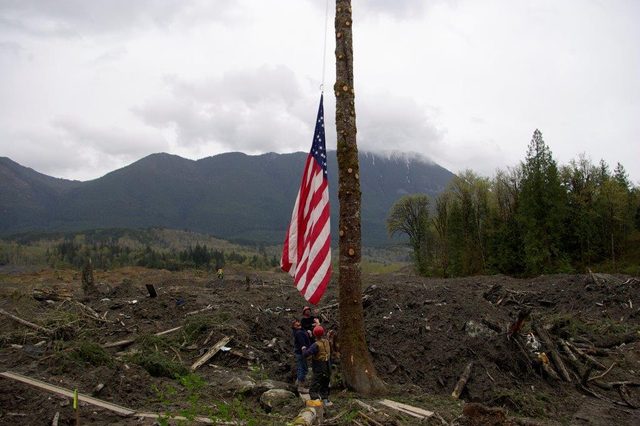
I have lived in four states and seven countries. I’ve traveled the U.S. and the world. I have never known a town so tuned into the needs of all others and so able to immediately encounter any disaster, as the Oso Mudslide of 2014, without waiting for outside help.
Overcoming Tragedy
This isolated community in the North Cascades finds that by working for and with each other anything becomes possible. And it took one of the most tragic events in our area’s history to prove it. This is the story of that tragic event and how this special place reacted.
Childhood, called “the formative years,” influences the rest of one’s life. Grow up with good people and you’re likely to be good throughout life. Generations of people living in the isolated community of Darrington, WA, have made the town one which is a positive influence for anyone fortunate enough to spend their life, or even part of their life, amidst such good people.
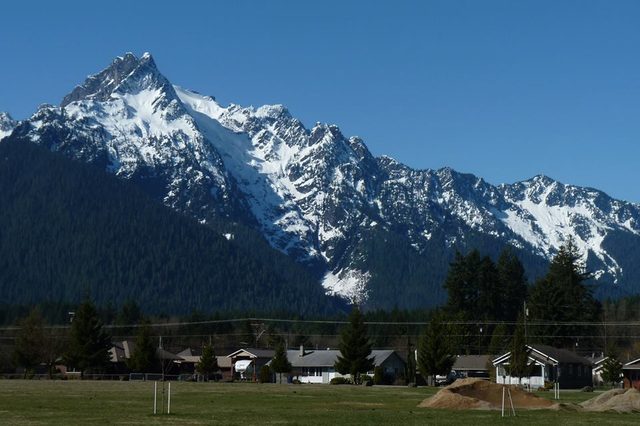
Darrington, in the north Cascade Mountains, has a population of about 1,347 and an area of 1.67 square miles. There are three rivers flowing nearby, the Sauk, Suiattle, and the Stillaguamish, and it is surrounded by three wilderness areas, the largest being Glacier Peak Wilderness. The largest employers are Hampton Lumber, the logging industry, the school system, and the Forest Service. It grew with the migration of Tarheels in 1916 from North Carolina to cut timber needed in fighting World War I and now combines a heritage of Southern hospitality with Northwest individualism. People here know responsibility, how to take care of themselves and their neighbors. They pull together in good times and in bad.
The greatest test of strength and fortitude came on Saturday morning, March 22, 2014 when a large portion of Mt. Higgins fell into the Stillaguamish River, an event now known as the Oso slide and described as the deadliest single landslide event in U.S. history. Forty-three people died, 49 homes were destroyed, and the mud, rock and gravel was as much as 70 feet deep for over a square mile (800 acres). Darrington lies 12 miles east of the slide and response came immediately. The extent of the damage and the dangers of searching for survivors were not known. But those were their families and friends, and immediate action was required.
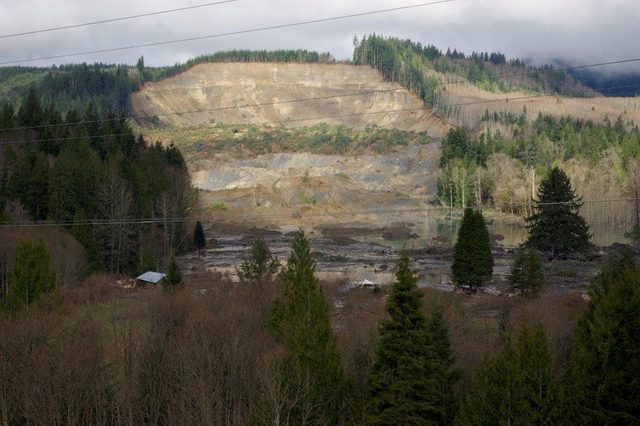
In the freezing rain of that March morning, crews of loggers with their heavy equipment — bulldozers, excavators, backhoes and front-end loaders — were instantly organized. They worked nonstop through that Saturday, Sunday and Monday at the slide area, described later as “a mountain of dirt, water, and broken trees.” The Food Bank in town organized residents to bring them meals, which they often ate on their machinery, knowing time was more important than rest.
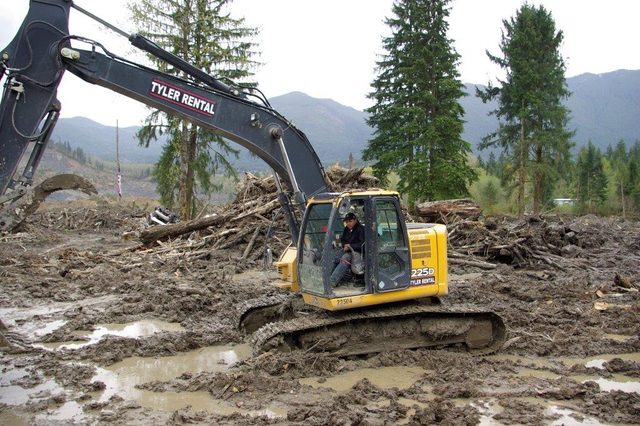
When officials from Snohomish County arrived later in the week, the Darrington loggers were ordered out for safety reasons: the mountain could slide further, and the mud was contaminated by chemicals and bacteria. But the local men were not dissuaded and wouldn’t be stopped by rules and regulations. It was only because of their immediate efforts that nine people were found alive, the youngest among them Baby Duke, six months old. He still, three years later, receives surgery and has a plate in his head.
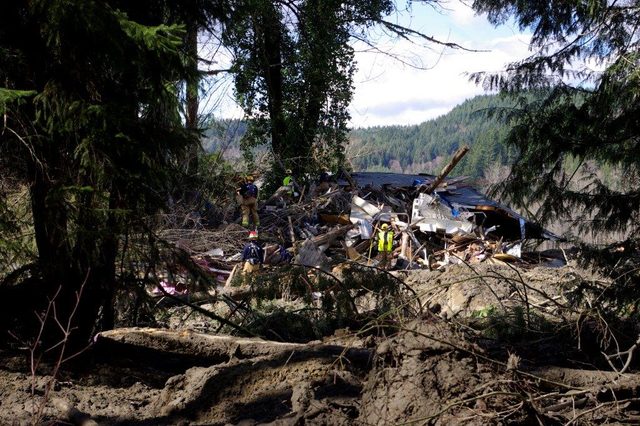
Of course they received FEMA aide, and President Obama saw the damage, but that came after the disaster was stabilized. When the rescue operation turned to a search for bodies, the many volunteers continued, digging through concrete-like hardened substances and carrying out the dead. The county eventually called off their own search, but the loggers would not give up until the remaining two were brought out of the debris. One was found on May 22 and the final one on July 22, two months and four months after the slide to the day.
Darrington was cut off from Arlington, the nearest town, so an alternate route had to be made in order to get supplies and equipment. Taking it upon themselves to do so, the Darrington men cut a route to the powerline road over the standing Skaglund Hill. When this temporary road was not approved by the county for being unsafe, stability had to be added, so almost overnight the locals came in and upgraded the seldom-used road with some pavement and lots of gravel to assure a safe traffic flow.
The women in town, meanwhile, were busy organizing food kitchens for the workers as well as those survivors with no home standing. They packed 60 lunches and dinners each day because the men would not leave their machines. Two of the residents near the slide filled their garages with donated food, boots, and clothes and organized a much-needed laundry for the men on the site. When FEMA came in after the first week, their comment was, “We’ve never seen a community like that, so self reliant.” The answer from the community was, “I think we can handle it.” Even the Washington Search and Rescue Task Force, sent up from Seattle, admitted they learned by Darrington’s example. The experts in searches of that management team found that they should and must incorporate the hundreds of local volunteers who not only knew what they were doing, but could do it all more effectively.
While the search was still ongoing, Darrington loggers attached two flags from trees shorn of branches, lifting 60 feet above gravel at the scene. The flags were raised to show no lack of hope, no defeat. They raised spirits.
Forty-three trees have been planted there, one for each victim, and money is being raised for a concrete memorial and parking area. The town commemorates the victims each year with a service on March 22 beginning at ten. Families who lost members remain with each other throughout that day and lanterns are released into the air at dark at the site.
A Place to Call Home
I grew up at Oso, four miles from the sight of the landslide, and attended the two-room schoolhouse before moving away for high school and college. I was anxious to return to my home town to teach for the next 18 years where I was readily hired and welcomed home. Only great memories come from my career at Darrington High School. As a teacher I was always respected and known as an important part of the community. Often after work I’d find a sack of fresh vegetables in the car. When someone from an opposing basketball event had slashed my tires, my students went to their homes at 11 at night and returned with their parents’ spare tires and mounted them on my car. When my mailbox was flattened by a teen who had failed my class, the welding shop at the school made me a solid steel box, opened by a horseshoe, decorated with an iron horse atop, and mounted on an iron post secured with a car engine buried in concrete and gravel. No one ever messed with my mailbox again.
Even in this town of 1,300, not everyone knows everyone. But most of the townsfolk know who owns what kids, cars, and dogs, even remember many of the others’ phone numbers. People keep an eye out for each other. If I were stuck in the mud or the snow at midnight driving home, I knew ten or twelve people I could call to come and assist.
It isn’t uncommon for seniors living alone to find their lawns mowed and raked of leaves, their woodshed filled for the winter, their driveways shoveled of snow. After an auto accident permanently injured young Tara Evans in her freshman year of school, she later took on the daily task of cleaning the streets of trash. An obvious sight on her 4-wheel bike, the flags give warning to use caution and give her berth on the streets, or to slow down, stop, and say, “Hi.” When my hay needed cut, someone did the job and stacked bales in my barn. When a farmer’s barned burned, a crew showed up the next day with lumber and tools and rebuilt it better than before.
Death is yet another time for sharing and caring. The service is held in the church of another denomination if the chapel of one won’t hold the crowd. Besides sharing buildings, the churches share their love and after a funeral it is common to bring food for the reception. One church provides salads, another breads, another the main meal or desserts. People take part even if they don’t attend the burial.
A Strong Foundation Built on Solid Wood
What town still uses and boasts of its 63-year-old high school gymnasium? Darrington does. The gym, built in 1954 of volunteer labor and materials, is one of the classic gyms of Washington state. Most cities and towns pass multi-million dollar levies to construct a school gym or a community center, but Darrington did it all on their own dime and their own time. When the floor of glowing Alaskan cedar needed replacement after 60 years of use, the town raised the $200,000 needed by selling pieces of the old floor, hosting spaghetti feeds, and accepting donations; keeping with tradition, the new lumber was milled locally.
Living in the valley 540 feet above sea level, under guardianship of the 6,570 foot Whitehorse Mountain, residents know long winters of fog, drizzle, snow and rain. Loggers are shut out of the woods filled with snow, the mill slows down, and entertainment moves indoors. With no movie theater or bowling alley or mall around, high school sports draw all attention, especially basketball. (Their mascot, of course, is The Loggers.) Couples get together for a meal, card games, or bluegrass music played once a month in the community center. The people anxiously await the signs of spring and love the outdoors in the summer. Summer means picnics at the river, bonfires in the evening, or just sitting on the porches and gathering. No one has to go indoors until after 9 p.m. when the sun finally sets and the evenings become cool.
Some kept horses to ride the wilderness trails, to hunt deer and mountain goat, but not to rodeo; yet in 1964 they formed the Darrington Horse Owners’ Association and set in to build their rodeo arena, all volunteer labor and materials. For 50 years they have held their yearly Darrington Timber Bowl Rodeo in June and have used the grounds for many other outdoor events.
A Big Small Town
Being Southern, they love bluegrass music. When the rodeo arena area became too small to hold bluegrass crowds, in 1977 they built next to it the bluegrass grounds, which now hosts one of the largest bluegrass festivals in the country. It is also the oldest running festival of its kind in the Pacific Northwest. Thousands hear music from bands throughout the nation for a week each July, and with professionals and amateurs playing continuously ten hours each day, the town stays in a very festive mood. The high school graduation ceremonies take place there, weather permitting, and the seniors themselves are responsible for cleaning and readying the outdoor stage for their own celebration.
Darrington also has, since the 80’s, hosted every August both national and international Archery events, with participants coming as far as New Zealand, South Africa, and Germany to compete. Darrington has the only permanent archery range in the U.S. — seven ranges in fact. We didn’t think we had the facilities or abilities to submit application for national events, but Darrington has a “Yes, we can” attitude. Marv Kastning, a high school teacher, conceived the idea, enlisted first his students and then the town to build the archery range and trails, to advertise his plans, and eventually to make the dream of hosting Archery in Darrington a reality. This June they will host the National Olympics Rounds.
Of course, Darrington is a very small town. It has one motel and two restaurants. When 6,000 come to town for Rodeo, Bluegrass, or Archery, where do they stay? Many have campers and trailers, this being the Northwest, but just as many drive up from Seattle or Tacoma or even Spokane or California and have nowhere to stay. The solution? Darrington opens its homes to visitors, the whole town becoming a big bed and breakfast. Staying in the homes of residents has often produced lasting friendships. People soon learn where to go to be taken in.
One old timer told me, and I’ll never forget it, “I’ve never been out something to do here.”
The town has the usual features of small communities: a Senior Center with weekday activities such as exercise classes, bridge games, crafts and meals; a farmers’ market in the summer; a historical society, which sponsors a talent show; and the Darrington Strong group, which meets twice monthly to organize street fairs, the July 4th Parade and Darrington Days, and to advertise hiking, fishing, rafting and hunting activities. Last Thanksgiving the local restaurant The Hawk’s Nest opened its doors to anyone needing a turkey dinner and ended up serving almost 300 meals.
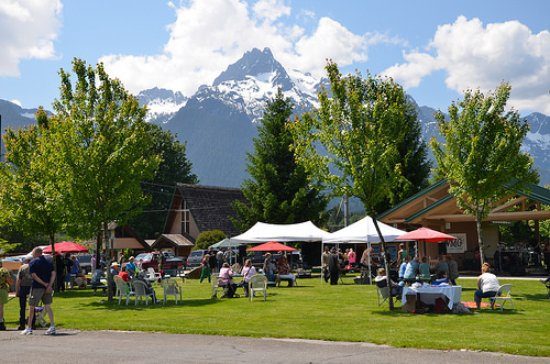
“Home is the place, when you have to go, they have to take you in,” wrote Robert Frost. But a home town is a place you want to go and they want to take you in. How lucky are those who have a home town. How fortunate to be remembered and to be welcomed back and invited in without reservation, from only a phone call.
(Appreciation is given to Shari Brewer, Dayn Bruner, and Rita Mauldin for information within this article and to Martha Rasmussen for pictures.)
Darrington Thanks YOU from Collective7 on Vimeo.
What do you think of Darrington, WA?